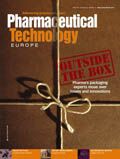The Relationship Between Packaging And The Patient
Pharmaceutical Technology Europe
In light of the challenges facing the pharma industry, such as changing patient demands and changing demographics, the relationship between the packaging, the consumer and the product is being completely reconsidered.
This article is part of a special feature on packaging that was published in the May issue of PTE Digital, available at http://www.pharmtech.com/ptedigital0511.
In light of the challenges facing the pharma industry, such as changing patient demands and changing demographics, the relationship between the packaging, the consumer, and the product is being completely reconsidered as marketing and brand managers realise how beneficial well-designed packaging can be. For OTC products, good packaging can improve brand communication in a highly competitive market. If packaging is attractive, interactive, portable and a helpful reference, then the user is more likely to build a positive response to the product. Packaging that is not user friendly or that does not clearly communicate the added benefits of the medicine, will hold the brand back.

Tim Clarke, CEO, healthcare and technology, at Burgopak Ltd.
First impressions are crucial. When a consumer receives a product, their first interaction before taking the medicine is the packaging. Packaging that distracts the patient from thinking about their illness, but focuses them on the benefits of taking the medication is key. Think like a patient. What does the packaging say to them? Is it easy to use? Environmentally friendly? Well designed with clear communication? These are a few of thoughts that take place before the medicine has even been used. Smart packaging can help to make the patient feel more secure and well informed, and this can help improve compliance, which is a big issue in the pharma industry.
Industry issues
One problem with traditional medical packaging is that the leaflet, medicine and outer carton are separate components. Patient information leaflets are usually large once opened up and are almost impossible to reassemble back into the outer carton! Leaflets may then be discarded, leaving the patient with no reference point if they have any concerns regarding the medication they are taking. This can result in the patient not taking the medication correctly and prolonging their illness. Intelligent packaging design that is user friendly, functional and influences the patient to interact with the packaging helps support compliance.
One big issue for the pharma industry is general regulation, which is ever changing and becoming more stringent. In the area of packaging, however, the regulatory requirements for text and graphics have remained largely unchanged for many years, with the one notable exception of the mandate to include Braille on the outer carton. In the highly competitive market of OTC packaging, regulators, such as the UK's Medicines and Healthcare products Regulatory Agency, do appear to be getting stricter about not over-emphasising a product's benefits through claims such as "Max. Strength" and "Faster Acting".
Another problem in the industry is counterfeiting. Most pharma companies have adopted covert solutions to tackle this problem. However, packaging differentiation can also play a role. If a package is innovative and more difficult to produce than traditional packets and cartons, it may discourage counterfeiting.
Some packaging solutions are available that address all of these issues in a single pack; ultimately, improving patient compliance, discouraging counterfeiting and keeping the manufacturer's brand in front of the patient.

Pharmaceutical Tariffs Are Imminent: How Industry is Bracing for Impact
April 16th 2025On April 14, 2025, the Trump Administration launched a national security-driven investigation into pharmaceuticals, a move that will likely result in tariffs being placed on pharmaceutical drugs, ingredients, and other components that are imported from outside of the United States.
Drug Solutions Podcast: A Closer Look at mRNA in Oncology and Vaccines
April 30th 2024In this episode fo the Drug Solutions Podcast, etherna’s vice-president of Technology and Innovation, Stefaan De Koker, discusses the merits and challenges of using mRNA as the foundation for therapeutics in oncology as well as for vaccines.